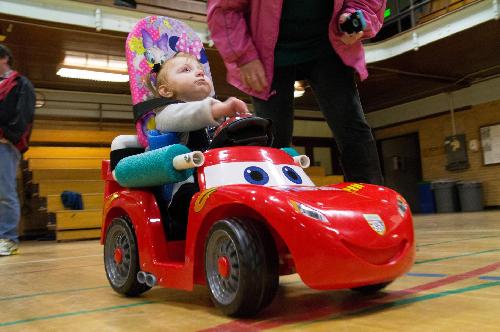CORVALLIS, Ore. - Typical toddlers simultaneously spend about three hours a day in physical activity, play and engagement with objects such as toys, while their peers with mobility disabilities are less likely to engage in all of those behaviors at the same time, new research from Oregon State University shows.
The study shows the marked differences in play and activity among toddlers with and without disabilities. It also underscores the need for young children with disabilities to have opportunities to play and explore in the same manner as their peers, said the study's lead author, Sam Logan.
"Whatever typically-developing kids do should be the gold standard for all children, including those with disabilities," said Logan, an assistant professor of kinesiology in the College of Public Health and Human Sciences. "The ability to move independently is a mechanism for a host of developmental benefits for children."
 In this image, a toddler uses a Go Baby Go modified toy car. Credit: Oregon State University
In this image, a toddler uses a Go Baby Go modified toy car. Credit: Oregon State University
Physical activity has important physiological benefits for children, but it also is a vehicle through which children can engage with their peers and interact with their surroundings, Logan said. One way researchers are now encouraging children with mobility disabilities to move more is through the use of modified toy ride-on cars.
Past research has shown that independent mobility is linked to cognitive, social, motor, language and other developmental benefits in young children. Being pushed in a stroller or being carried from one place to another is fundamentally different from having active control over one's own exploration, which is where the developmental gains are seen, he said.
The latest study, published recently in the journal Pediatric Physical Therapy, compared the activity of typically-developing toddlers to those with disabilities, with a particular focus on the co-occurrence of play, physical activity and engagement with objects such as toys.
The researchers found that typically-developing toddlers spent about an hour per day in direct play interactions with their peers, while toddlers with disabilities affecting mobility spent less than 20 minutes and as few as six minutes per day in similar interactions.
The toddlers with disabilities also had less variety in the types of physical activity they engaged in and were less likely to interact with objects such as toys, Logan said. One of the goals for physical therapists and other clinicians should be to encourage more simultaneous activity, he said.
"Moving is not the objective, but if you're not able to move independently, then play with peers or interaction with toys is even more difficult," Logan said. "So how can we help these kids move more for play?"
One challenge is the lack of commercially-available devices to help toddlers with mobility issues to get around on their own, Logan said. Power wheelchairs can be costly and typically aren't available for children until they are older, and may not always be an option at all for children who are expected to eventually be able to walk.
Some low-cost interventions are emerging to help address this issue. Logan is a leader of the Go Baby Go program, which provides children with movement disabilities modified ride-on toy cars.
The cars give children independence at a much younger age, allowing them the mobility needed to increase their interaction with peers and other objects, Logan said. The modified cars have proven effective even among children with complex medical issues, he said.
A case study on the cars' use among children with complex medical issues, including use of tracheotomy tubes and ventilators for aid in breathing, was also published recently in the journal Pediatric Physical Therapy.
The three children featured in the study, ranging in age from 6 months to 5 years of age, learned to drive modified ride-on cars independently. The children used the cars to explore their environment and some of the children also participated in play-based activities using the cars.
"The car becomes a tool," Logan said. "It's not just about getting from point A to point B. "It's about how the child is using the car to play and interact with peers and objects."
Together, the two studies provide further evidence of the benefits of mobility for children with disabilities and the effectiveness the modified cars in helping children gain that mobility, Logan said.
His latest research is focused on modified cars that require children to stand to operate them, which helps build muscle strength and prepare children for walking, and further reduces barriers for play and socialization with peers.
"The expectation should be that they have the same opportunities for mobility and play as any other kids," Logan said. "Even the most complicated medical cases should not be barriers for play."
source: Oregon State University